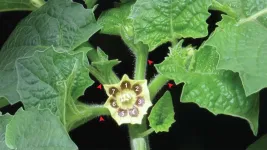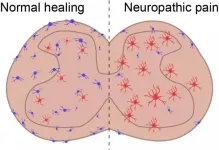(Press-News.org) UNIVERSITY PARK, Pa. -- While women can be drawn into farming for many reasons, researchers in Penn State's College of Agricultural Sciences have found that female-owned farms in the U.S. are more common in areas that are closer to urban markets, that engage in agritourism activity, and that offer greater access to childcare.
The number of farms operated by women has risen over the past two decades, said Claudia Schmidt, assistant professor of marketing and local/regional food systems.
The U.S. Department of Agriculture changed the way it counts the operators of farms in its most recent Census of Agriculture, allowing for up to four principal operators per farm. This has inflated the number of female operators somewhat, but female participation in agriculture is nonetheless at an all-time high, said Schmidt.
"This type of research is needed not just for reasons of equity, but also to support a more diverse and resilient agricultural sector in general," said Schmidt. "Without knowing more about female farm-operators' decision making, agricultural service providers have had to make assumptions about the type of information and products that are useful to them. Our analysis shows some of the ways in which female-owned farms are unique and it can offer important insights into how best to serve this population."
Using data from the U.S. Census of Agriculture from 2002-2017, Schmidt and her colleagues developed a statistical model to examine the relationship between a county's share of female-operated farms and the conditions in the county. Their goal was to shed light on aspects of the local economic and agricultural ecosystems that are most strongly associated with female-owned farms.
The researchers identified 10 economic variables hypothesized to matter, including unemployment, non-farm wages, availability of childcare, and the rate of female participation in the labor force. They also examined the total number of farms, average farm size and annual sales, average farmer age, and the types of farm activities carried out. They looked at each variable in isolation to determine which variables are independently and most strongly associated with the share of female-operated farms.
"We wanted to understand why women are drawn to farming," said Stephan Goetz, professor of agricultural and regional economics and director of the Northeast Regional Center for Rural Development (NERCRD). "Is it because they want to engage in this kind of work, or is it because they are pushed into farming due to a lack of other economic opportunities locally? We also wanted to examine how local agricultural conditions -- what farming generally looks like in a given place -- relate to women's participation in agriculture."
The analysis, which was recently published in Food Policy, shows that more female-owned farms are found where average farm size is below 50 acres, where annual farm sales average less than $10,000 per farm, where more farms specialize in grazing sheep or goats, and where agritourism activities -- which attract visitors to farms -- are more common.
The researchers also found that direct-to-consumer sales are more prevalent in counties with more female-owned farms. It is therefore not surprising that urban areas with high population densities have more female-owned farms than more rural areas do, said Goetz.
"Our findings suggest that females are more likely to engage in the type of farming that benefits from being in or near urban locations," said Goetz. "In addition to offering more opportunities to market directly to consumers, urban and suburban locations also offer greater access to childcare than rural areas, and our research showed the availability of childcare is correlated with the number of female-owned farms in a county."
The researchers also noted that the share of farms with female operators is higher in counties with a greater total number of farms, which could reflect increased opportunities for networking and learning through knowledge-sharing networks.
"Our research suggests that female-owned farms are more common in certain economic and agricultural ecosystems," Schmidt said. "Therefore, they likely have different needs in terms of education and support, and this research is an important step in identifying these differences."
Among other questions, future research will look at the impact of female-owned farms on local economic and agricultural conditions.
INFORMATION:
Zheng Tian, a research associate at the NERCRD, also contributed to this research, which was funded by the U.S. Department of Agriculture National Institute of Food and Agriculture and by Hatch/Multi-State Appropriations under Project #PEN04633 and Accession #1014522.
COVID-19 is only the latest infectious disease to have had an outsized impact on human life. A new study employing ancient human DNA reveals how tuberculosis has affected European populations over the past 2,000 years, specifically the impact that disease has had on the human genome. This work, which publishes March 4 in the American Journal of Human Genetics, has implications for studying not only evolutionary genetics, but also how genetics can influence the immune system.
"Present-day humans are the descendants of those who have survived many things--climate changes and big ...
To succeed in mating, many male frogs sit in one place and call to their potential mates. But this raises an important question familiar to anyone trying to listen to someone talking at a busy cocktail party: how does a female hear and then find a choice male of her own species among all the irrelevant background noise, including the sound of other frog species? Now, researchers reporting March 4 in the journal Current Biology have found that they do it thanks to a set of lungs that, when inflated, reduce their eardrum's sensitivity to environmental noise in a specific frequency range, making it easier to zero in on the ...
Brain cells called astrocytes derived from the induced pluripotent stem cells of patients with bipolar disorder offer suboptimal support for neuronal activity. In a paper appearing March 4th in the journal Stem Cell Reports, researchers show that this malfunction can be traced to an inflammation-promoting molecule called interleukin-6 (IL-6), which is secreted by astrocytes. The results highlight the potential role of astrocyte-mediated inflammatory signaling in the psychiatric disease, although further investigation is needed.
"Our findings suggest that IL-6 may contribute to defects associated with bipolar disorder, opening new avenues for clinical intervention," says co-senior study author Fred Gage ...
New collaborative research from Northwestern University and Lund University may have people heading to their backyard instead of the store at the outset of this year's mosquito season.
Often used as an additive for cat toys and treats due to its euphoric and hallucinogenic effects on cats, catnip has also long been known for its powerful repellent action on insects, mosquitoes in particular. Recent research shows catnip compounds to be at least as effective as synthetic insect repellents such as DEET.
But until now, the mechanism that triggered insects' aversion to this common member of the mint family was unknown. In a paper ...
Existing gene drive technologies could be combined to help control the invasive grey squirrel population in the UK with little risk to other populations, according to a modelling study published in Scientific Reports.
Gene drives introduce genes into a population that have been changed to induce infertility in females, allowing for the control of population size. However, they face technical challenges, such as controlling the spread of altered genes as gene drive individuals mate with wild individuals, and the development of genetic resistance, which may render the gene drive ineffective.
To address these challenges, Nicky Faber and colleagues used computer modelling to investigate the effectiveness of a combination of three gene ...
Using theoretical models of bacterial metabolism and reproduction, scientists can predict the type of resistance that bacteria will develop when they are exposed to antibiotics. This has now been shown by an Uppsala University research team, in collaboration with colleagues in Cologne, Germany. The study is published in the journal Nature Ecology and Evolution.
In medical and pharmaceutical research, there is keen interest in finding the answer to how fast, and through which mechanisms, bacteria develop antibiotic resistance. Another goal is to understand how this resistance, in turn, affects bacterial growth and pathogenicity.
"This kind of knowledge would enable better tracking and slowing ...
Induced pluripotent stem cells (iPSC) are suitable for discovering the genes that underly complex and also rare genetic diseases. Scientists from the German Cancer Research Center (DKFZ) and the European Molecular Biology Laboratory (EMBL), together with international partners, have studied genotype-phenotype relationships in iPSCs using data from approximately one thousand donors.
Tens of thousands of tiny genetic variations (SNPs, single nucleotide polymorphisms) have been identified in the human genome that are associated with specific diseases. Many of these genetic variants are ...
A team of scientists from the University of Cologne (Germany) and the University of Uppsala (Sweden) has created a model that can describe and predict the evolution of antibiotic resistance in bacteria. Resistance to antibiotics evolves through a variety of mechanisms. A central and still unresolved question is how resistance evolution affects cell growth at different drug concentrations. The new model predicts growth rates and resistance levels of common resistant bacterial mutants at different drug doses. These predictions are confirmed by empirical growth inhibition curves and genomic data from Escherichia coli populations. ...
Over evolutionary time scales, a single gene may acquire different roles in diverging species. However, revealing the multiple hidden roles of a gene was not possible before genome editing came along. Cold Spring Harbor Laboratory (CSHL) Professor and HHMI Investigator Zach Lippman and CSHL postdoctoral fellow Anat Hendelman collaborated with Idan Efroni, HHMI International Investigator at Hebrew University Faculty of Agriculture in Israel, to uncover this mystery. They dissected the activity of a developmental gene, WOX9, in different plants and at different moments in development. Using genome editing, they found that without changing the protein produced by the gene, they ...
CHAPEL HILL, NC - One of the hallmarks of chronic pain is inflammation, and scientists at the UNC School of Medicine have discovered that anti-inflammatory cells called MRC1+ macrophages are dysfunctional in an animal model of neuropathic pain. Returning these cells to their normal state could offer a route to treating debilitating pain caused by nerve damage or a malfunctioning nervous system.
The researchers, who published their work in Neuron, found that stimulating the expression of an anti-inflammatory protein called CD163 reduced signs of neuroinflammation in the spinal cord of mice with neuropathic pain.
"Macrophages are a type of immune cell that are found in the blood and in tissues ...



